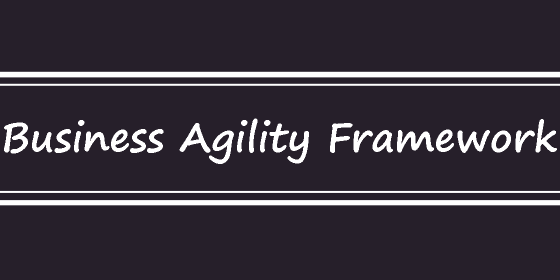Business Agility Framework

A Business Agility Framework is a structured and flexible approach that organizations adopt to enhance their agility and adaptability in response to changing market conditions, customer needs, and competitive landscapes. It is designed to help organizations transform and thrive in today’s rapidly evolving business environment.
Key points about a Business Agility Framework include:
- Holistic Perspective: A Business Agility Framework takes a holistic view of the organization, encompassing various aspects such as strategy, culture, leadership, processes, technology, and people.
- Agile Principles and Practices: The framework often draws inspiration from Agile principles and practices used in software development and extends them to other areas of the organization beyond IT.
- Cross-Functional Collaboration: Business Agility emphasizes breaking down silos and promoting cross-functional collaboration, enabling teams to work together seamlessly toward common goals.
- Customer-Centricity: Business Agility frameworks emphasize customer-centricity, focusing on understanding and meeting customer needs and delivering value quickly.
- Continuous Learning and Improvement: Continuous learning and improvement are at the core of Business Agility. Organizations foster a culture of experimentation, learning from failures, and continuously refining their processes.
- Adaptive Leadership: Business Agility frameworks often require a shift in leadership styles, emphasizing adaptive leadership that empowers teams and embraces change.
- Iterative and Incremental Approach: Like Agile methodologies, Business Agility embraces an iterative and incremental approach to achieving outcomes. Organizations make incremental improvements and adapt their strategies based on feedback and insights.
- Value Stream Optimization: Business Agility frameworks often focus on optimizing end-to-end value streams, removing bottlenecks, and reducing lead times for delivering value to customers.
- Resilience and Antifragility: Business Agility aims to build resilience and antifragility, enabling organizations to not only survive but thrive in the face of disruptions and uncertainty.
- Customization to Context: Business Agility Frameworks are adaptable and customizable to the unique context and needs of each organization. There is no one-size-fits-all solution.
Common Business Agility Frameworks include SAFe (Scaled Agile Framework), LeSS (Large-Scale Scrum), Scrum@Scale, and Disciplined Agile (DA), among others. These frameworks provide guidance and structure for organizations undergoing large-scale Agile transformations.
However, it’s important to note that each organization’s journey toward business agility will be unique, and frameworks should be tailored to suit the organization’s specific culture, goals, and challenges.
In summary, a Business Agility Framework is a comprehensive approach that guides organizations in their pursuit of agility, adaptability, and customer-centricity, helping them thrive in a dynamic and competitive business landscape.